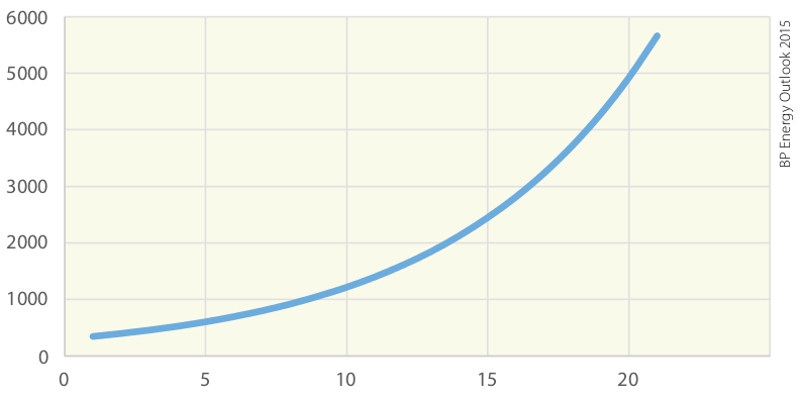It’s green all over. NOT! Contrary to a growing perception by the public, it’s almost all black. Coal, oil and gas still predominate as energy carriers.
Let’s look at some numbers to authenticate this statement.
In 2015 the world’s total energy consumption was 13,200 MMtoe. Out of this, fossil fuels (coal, oil and gas) made up 11,300 MMtoe; that amounts to 86%. Renewables (wind, solar, biomass, but not including hydroelectricity) produced 350 MMtoe, a tenfold increase in 20 years, but still a mere 2.6% of the total consumption (the gap is filled by nuclear energy and hydroelectricity.)
 Given an exponential increase in the use of renewables, the use of fossil fuels can shrink by 25% in 20 years’ time. Renewables in million tons of oil equivalent on the vertical axis. (Source: BP)As the oil price depends partly on total energy consumption, and also on how much of the demand can be met by energy carriers other than fossil fuels at a competitive price, it is interesting to look at how much of the energy demand can be covered by renewables. According to the BP Energy Outlook 2015, 20 years from now renewables may have increased their share of the consumption budget to 6.7%. During the same time, fossil fuels will have reduced their share to 81%, meaning that renewables are increasing at the expense of fossil fuels – but they are not.
Given an exponential increase in the use of renewables, the use of fossil fuels can shrink by 25% in 20 years’ time. Renewables in million tons of oil equivalent on the vertical axis. (Source: BP)As the oil price depends partly on total energy consumption, and also on how much of the demand can be met by energy carriers other than fossil fuels at a competitive price, it is interesting to look at how much of the energy demand can be covered by renewables. According to the BP Energy Outlook 2015, 20 years from now renewables may have increased their share of the consumption budget to 6.7%. During the same time, fossil fuels will have reduced their share to 81%, meaning that renewables are increasing at the expense of fossil fuels – but they are not.
The truth is that, with this scenario, the actual increase in the use of fossil fuels amounts to 25%. This means that, if we believe the BP numbers, fossil fuels have not peaked at all; instead, their use will continue to grow.
BP may, of course, be wrong. Perhaps their experts are not taking into account a potential exponential increase in the technological development of renewables. In fact, from 2010 to 2015 the use of renewables did have an exponential increase (an average of 15% every year). What if this 15% growth continues for the next 20 years? The mathematicians give us the answer: renewables will then produce 5,600 MMtoe – as opposed to the BP prediction of 1,180 MMtoe.
Given that this scenario does not change the total energy consumption, in 2035 renewables will have a share of 32%. Would this be at the expense of fossil fuels?
If we assume that the use of hydroelectricity and nuclear energy continue to grow according to the BP prediction, this also means that our consumption of fossil fuels in 2035 will be about 10,000 MMtoe (73,333 MMboe); a reduction of 25% compared to 2015.
And yes, a 15% annual growth is substantial….
As ever, technology is key.




